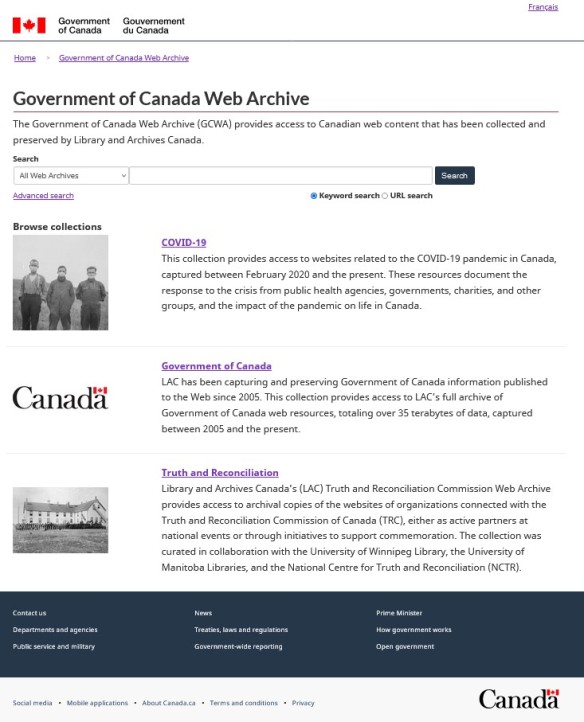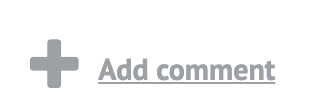The following is a press release issued by Library and Archives Canada:
Introduction and program history
Library and Archives Canada (LAC) is the nation’s designated national memory institution, with a legislated mandate to acquire, describe, preserve and provide long-term access to Canada’s documentary heritage.
This includes the Canadian Web! Resources in formats for the Web are recognized internationally as an important facet of a nation’s modern digital heritage. These irreplaceable web resources are important evidence of Canadian history and culture in the 21st century, but they are volatile and prone to disappearing without warning.
What can be done about this? How do we “rescue” resources generated in real time, which exist outside the normal production streams of archival records or traditional publications? How do we safeguard web resources that can therefore contain information found in no other medium, which may document national historic events or important aspects of culture as they are unfolding?
Owing to their precarious nature, immediate and managed action is required to select, arrange, make available and ensure the digital preservation and data continuity of web resources that constitute Canadian digital documentary heritage. This action is referred to internationally as “web archiving,” which is a discipline based on digital preservation and curation that is practiced and advanced by, for example, the 50-plus members of the International Internet Preservation Consortium (of which LAC is a founding member).
Acquiring web resources became a formal part of LAC’s mandate in 2004 under the Library and Archives of Canada Act, subsection 8(2). LAC’s means of realizing this part of its mandate is the Web and Social Media Preservation Program within the Digital Services Sector. The program curates data and researches collections of unique web resources documenting Canadian historical and cultural themes and events, in alignment with the requirements of modern digital scholars. It also makes these resources available to the public for posterity and to support future international research on Canada.
The web resources acquired by the program are made available through the Government of Canada Web Archive (GCWA). While the program and the GCWA are well known in Canada, their scale may not be.
How big is the GCWA? How much data does the GCWA contain?
In 2022–23, the Web and Social Media Preservation Program at LAC reached an important milestone.
As of February 2023, we are pleased that the GCWA exceeded 120+ terabytes of total data and surpassed over 3.1 billion assets or documents.
This is about the same amount of data as 4,600 Blu-ray movie discs (1,150 in 4K, or 384 copies of your favourite movie trilogies in 4K). If the GCWA were printed out on paper, it would take up some 57.5 billion sheets; stacking this up, it would reach the same height as 12,263 CN Towers!
Some program clients may be surprised to hear this, because since 2005, LAC has only provided public access to portions of its federal web archival collections. This means that fully 50 percent of the total collections have therefore never been available to the public until now.

New functionalities and features of the relaunched Government of Canada Web Archive (GCWA)
New collections
We are delighted to announce that, with the relaunch of the GCWA in 2023, LAC will begin providing access to all non-federal collections curated since 2005. At the time of launch, the following collections will be available:
- The Truth and Reconciliation Commission Collection (curated in partnership with the Centre for Truth and Reconciliation, the University of Manitoba and the University of Winnipeg)
- The LAC collection on COVID-19 and its impacts on Canada (20+ terabytes of data)
- All federal government data collected since 2005 (55+ terabytes of data)
- Additional curated collections (to be arranged and published in the upcoming fiscal year)
The GCWA is one of the most comprehensive sources in existence for the following:
- Canadian cultural and historical events as documented on the Web (2005–)
- Official publications of the Government of Canada (GC) (2005–)
-
The federal and historical GC web presence (gc.ca domain, 2005–)
- Historical GC financial and departmental plans and performance reports (2005–)
- Historical GC policy frameworks (2005–)
- Historical GC proactive disclosure (2005–)
- Data and statistics from the federal web (2005–)
- Material removed from the federal web under Common Look and Feel 2.0 (2005–08)
- Material removed from the federal web under “CLF 3.0” (2008–13)
- Material removed from the federal web under the Web Renewal Initiative (2013–)
Overall, the GCWA is the definitive source for any historical study of the Government of Canada web domain over time.
New portal design
From 2005 to 2019, the GCWA arranged data according to, and only provided access to federal government web resources under, Crown copyright (at maximum, approximately 15 terabytes of data were available). With the launch of the new GCWA in 2023, we have expanded our search tools and filters to help users explore our non-federal data and thematic web collections.
Clients will now be able to engage non-federal collections in a specialized portal and user interface. The relevant interface (government versus non-federal collections) will be presented automatically based on the collection being accessed.
Full text search of the web archive, individual collections or collection themes
Since 2011, LAC has not provided a full-text search capability or service to the public for navigating the GCWA. This situation was very problematic, and it limited client access to discovery and browsing. For the launch in 2023, a complex and powerful full-text search will be made available:
- Clients will be able to search at multiple hierarchical levels, from the entire archive down to individual files.
- An advanced search will also be available, including the ability to search by collection, keywords, exclusions, exact phrase, URL/domain, web resource type and date range.
- An ability to quickly search by exact URL will also be available (useful for Reference Services and practitioners).
- Further, clients will be able to discover and access the content of non-federal collections by sub-theme (for example: show all resources collected having to do with the “economic impact on Canada of COVID-19”).
Specialized reference services
The Web and Social Media Preservation Program continues to provide all clients with specialized reference services for the GCWA. If you have difficulty locating a known resource within the GCWA, we would be pleased to assist you with the following:
- Locating obscure Government of Canada official publications or decommissioned websites
- Locating obscure historical reports, policies, financial data or proactive disclosure
- Locating genres of Government of Canada content where exact titles or dates are not known
- History and development of the Government of Canada domain (gc.ca)
- Use of the web archives as a historical source or as computational data
- Copyright or privacy concerns
- Questions on how to have your web resource digitally preserved at LAC
Do you have ideas on what should be collected? Please let us know!
Please forward all complex reference questions dealing with the web archive, nominations of Canadian web resources for acquisition, or requests for computational access to our web archival collections data team, at archivesweb-webarchives@bac-lac.gc.ca.
 Latest News Articles
Latest News Articles If you do not see a Plus Sign that is labeled "Add comment," you will need to upgrade to either a (FREE) Standard Edition or a (paid) Plus Edition subscription
If you do not see a Plus Sign that is labeled "Add comment," you will need to upgrade to either a (FREE) Standard Edition or a (paid) Plus Edition subscription